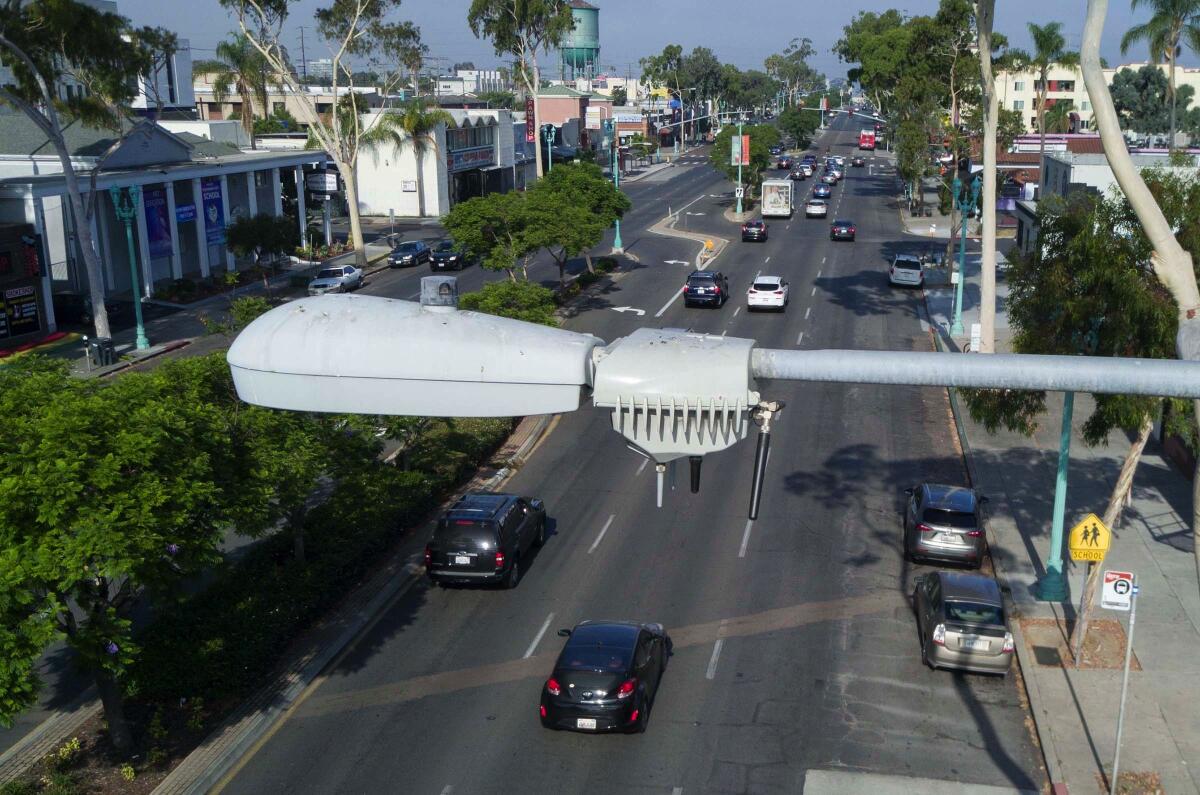San Diego police want to add surveillance tech: 500 streetlight cameras plus license plate readers

- Share via
SAN DIEGO — Almost three years ago, the city of San Diego cut off access to its broad network of Smart Streetlights — more than 3,000 devices perched atop light poles that could collect images and other data, some of which the Police Department used to solve criminal cases.
The city removed that access, at least without a warrant, because of concerns from the public about surveillance and privacy issues.
On Wednesday, the San Diego Police Department said it wants access to 500 of those devices to be restored — and they want to add another crime-solving tool to the network: automated license plate readers.
The controversy surrounding the Smart Streetlights began in 2019 when it was revealed that the cameras had been in place for three years without public input.
Police started accessing the camera footage in 2018 for investigations. Direct access was cut off in 2020 as a result of public outcry.
Because the Smart Streetlight cameras had not been well maintained over the years, the city would need to install new cameras. Adding the license plate reader technology would mark the first time the city of San Diego would have the readers in fixed locations.
This is the first big push for surveillance technology in San Diego since the city approved ordinances last year specifically setting rules to govern this kind of technology in light of privacy concerns.
Those ordinances lay out the lengthy process to win permission to use surveillance tech, and include holding community meetings to gather public input. There are 10 meetings planned throughout the city next week, and the department will accept public comments until 5 p.m. March 10.
The mayor’s office did not respond to requests for comment. The Union-Tribune also reached out to the office of Councilmember Monica Montgomery Steppe, who has pushed for transparency in the city’s use of the technology. Her office said it could not respond by the publication’s deadline.
The plan, if approved, would make San Diego the biggest city in the U.S. to use both cameras and license-plate readers as part of a single network, according to the Police Department. It would cost an estimated $4 million to roll out both the license plate recognition system and cameras. The department plans to pay for the program with funds from the city’s general fund and grants.
Police say the cameras and license plate readers are important investigative tools, and the department wants to use the cameras to investigate felony crimes, locate at-risk missing persons, respond to critical incidents and protect city assets and resources.
At a time when the department faces staffing shortages, the technology’s ability to assist officers in investigating and solving crimes acts as a “force multiplier,” Capt. Jeffrey Jordon said Wednesday. Jordon singled out license plate readers as “the biggest asset to law enforcement as far as technology that’s out there.”
“For us, particularly given our unique staffing needs, it is probably the most vital piece of technology that we can add right now to make a difference for our officers,” Jordon said.
According to a map provided by the department, the technology would be placed all around the city, from Carmel Mountain Ranch to San Ysidro. Many of the locations are near freeways and along thoroughfares. Locations include La Jolla Village Drive near Westfield UTC, Friars Road near Fashion Valley, Park Boulevard in Balboa Park, West Mission Bay Drive near Mission Bay, El Cajon Boulevard in City Heights, Market Street across several neighborhoods in southeastern San Diego, and Logan Avenue near Chicano Park.
Jordon said the department used crime data and input from investigators in units such as homicide, robbery, sex crimes and gangs to come up with the locations. “It was a combination of data and input,” Jordon said.
He said the department is open to moving the technology if concerns arise among community members about certain locations.
The cameras would be installed at angles that collect video of public areas, with the goal to stay away from areas where the public expects privacy.
Any video police decide to use to investigate crimes would be downloaded from the software. Other footage captured by cameras would be overwritten after 15 days. Facial recognition would not be part of the technology, according to the department.
Department officials said the camera feed would not be monitored in real time. Rather, it would be accessed as an investigative tool after a crime has been committed.
Similarly, the department would use the license plate readers for “official law enforcement purposes,” like when cars are stolen or wanted in connection with particular crimes, according to its proposed rules.
The technology would scan license plates as vehicles drive by and detect whether the number can be found in any law enforcement databases accessed by the system. If the system gets a hit, the software alerts the department’s dispatch center.
Police would be able to add license plate information to the system in order to be tipped off to wanted vehicles.
Compared with the cameras, more employees — including detectives — would have access to the license plate recognition technology. The data would be retained for 30 days, then deleted.
But first, police have to get permission to use the tech. To do so, it must follow the procedure laid out in the city’s two new surveillance tech ordinances.
Approved in August, together they are dubbed Transparent and Responsible Use of Surveillance Technology, or TRUST. One set rules governing technology use, the other created the Privacy Advisory Board to offer advice in hopes of ensuring transparency, accountability and public debate.
San Diego police plan to meet with the Privacy Advisory Board on March 15.
Several community groups came together to create TRUST San Diego Coalition, which helped craft the ordinances. Coalition steering committee member Seth Hall commended the city for “coming to the table prior to purchasing and installing this technology.”
“However, it’s important that communities and neighborhoods understand why this technology is being pointed at them, who benefits from having this technology in their neighborhood and what the exact costs are going to be to the taxpayers,” Hall said Wednesday.
“I wonder if there are things they would rather spend millions on in this city than mass surveillance technology,” he said.
The department commissioned an online survey, taken by 914 people, to collect their input about license plate readers and cameras in public.
The survey found that 42% of respondents said they would feel more safe if San Diego police used automatic license plate readers, and 13% said they would feel less safe. Nearly half — 47% — said they would feel safer if San Diego police use cameras in public spaces, and 10% said they would feel less safe.
The idea behind installing the $30-million Smart Streetlights program was to collect data on factors such as weather and pedestrian and vehicle movements to improve mobility on streets. But the city’s grand vision never materialized.
Still, the cameras tucked into the streetlights kept rolling. Most people had no idea they were there.
In 2018, police learned they could access the cameras — and started doing so to solve crimes, most of which were assaults, homicides, robberies and crashes resulting in serious or fatal injuries.
The public didn’t learn of the surveillance tech until 2019. The civil rights outcry that followed led San Diego to shut down the camera access until it could write rules to govern the use of the cameras and all surveillance tech. The idea behind the ordinances was to create better transparency and protect civil liberties.
Under the ordinances, surveillance technology will be looked at annually and through a civil rights lens. They call for a disclosure of data breaches and a look at whether gear is worth the money. The public will be able to debate surveillance technology proposals before the city moves forward with them.
For more information about the department’s proposed use of the technology and the meetings planned for next week, visit sandiego.gov/police/data-transparency/technology.
More to Read
Sign up for Essential California
The most important California stories and recommendations in your inbox every morning.
You may occasionally receive promotional content from the Los Angeles Times.















